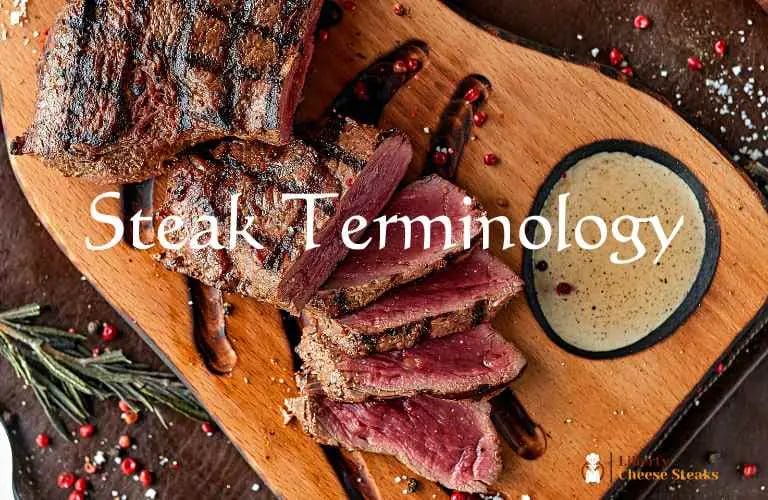Steak, a beloved dish worldwide, is more than just a piece of meat. It’s an experience, a culinary journey that begins with understanding the language of steak.
Whether you’re a steak enthusiast, a budding chef, or someone who simply enjoys a good meal, knowing steak terminologies can elevate your dining experience.
This comprehensive guide will delve into the world of steak, breaking down the jargon, and providing you with the knowledge to navigate steak menus with confidence.
What is Steak?
Before we delve into the terminologies, let’s define what a steak is. A steak is a cut of meat, usually beef, sliced perpendicular to the muscle fibers.
It can also refer to cuts from large fish like swordfish and tuna. Steaks can be cooked in a variety of ways, including grilling, pan-frying, broiling, and roasting.
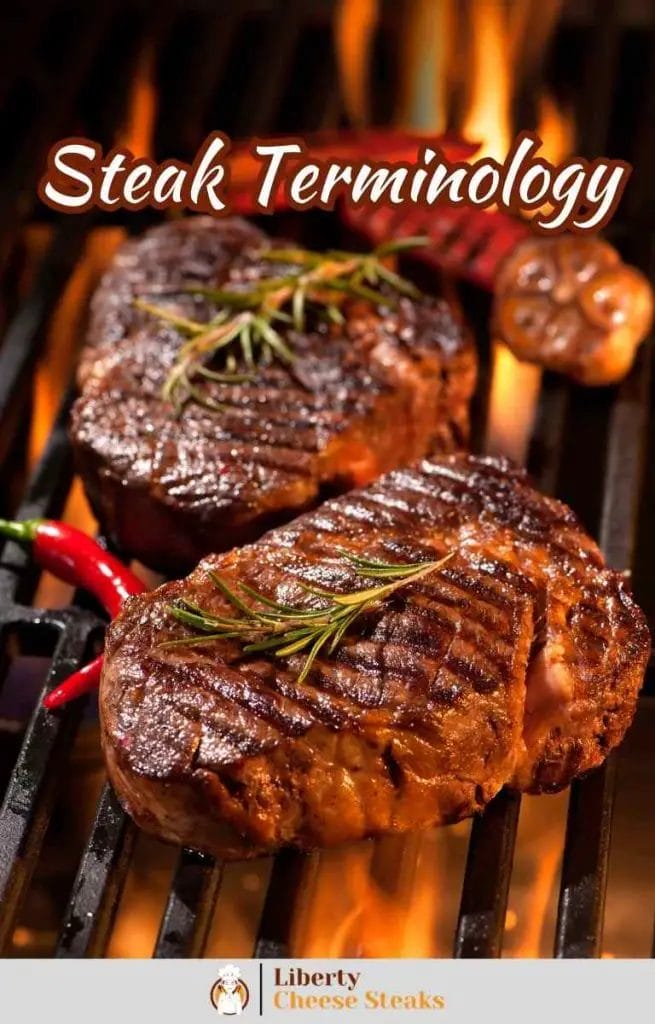
Steak Cuts
Understanding steak begins with knowing the different cuts. Each cut varies in texture, flavor, and ideal cooking method. Here are some of the most common steak cuts:
Filet Mignon
Also known as tenderloin steak, filet mignon is one of the most tender cuts of beef.
It’s lean with little fat, resulting in a mild flavor compared to fattier cuts. It’s often served with sauces or wrapped in bacon to enhance its flavor.
Ribeye
Ribeye is a favorite among steak lovers due to its rich, beefy flavor. This cut comes from the rib section and is characterized by its marbling, or streaks of fat interspersed with the lean meat.
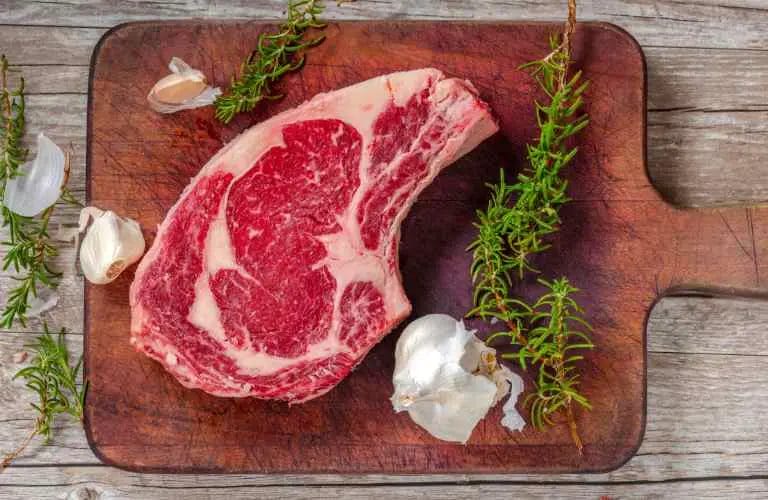
This fat melts during cooking, infusing the steak with flavor and juiciness.
New York Strip
The New York Strip, also known as a strip steak, comes from the short loin of the cow. It’s known for its balance of tenderness and robust flavor.
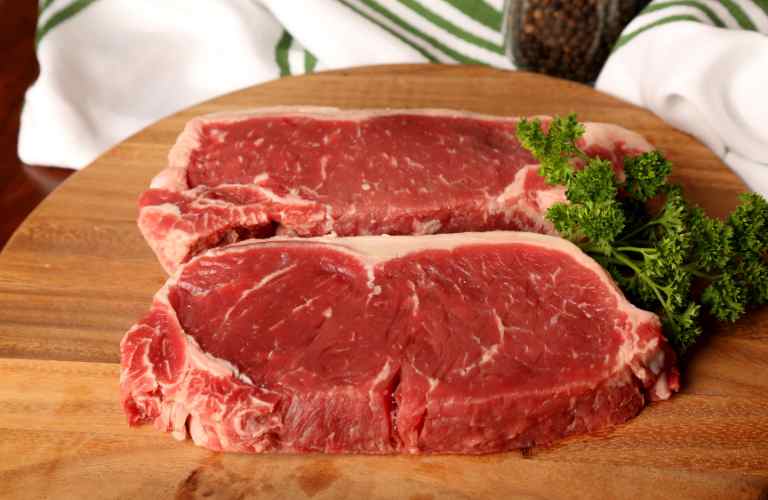
It has a strip of fat running along one side, which adds to its taste.
T-Bone
The T-Bone is a two-for-one cut. It includes a piece of tenderloin and a piece of strip separated by a T-shaped bone, hence the name.
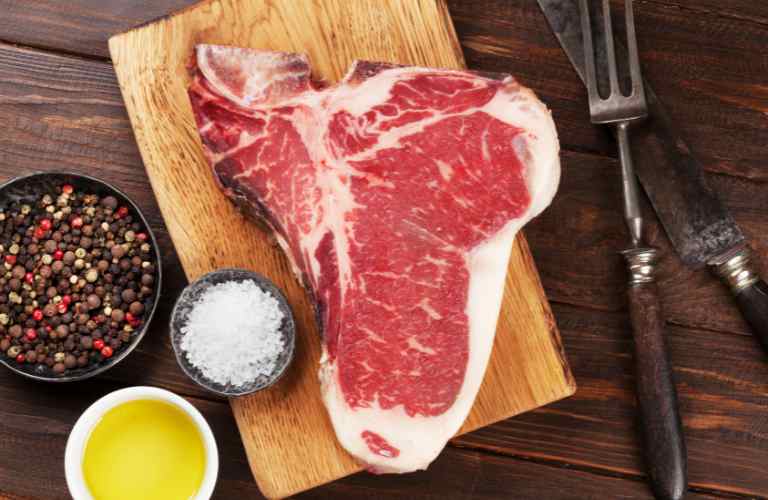
This cut offers a combination of the tenderness of the filet mignon and the flavor of the strip steak.
Porterhouse
The Porterhouse is similar to the T-Bone but larger. It contains a larger portion of tenderloin, making it a favorite for those who enjoy this tender cut.
Steak Grades
Steak grades are determined by the U.S. Department of Agriculture (USDA) and reflect the quality and amount of marbling, the age of the beef, and the texture, color, and appearance of the meat. Here are the three main grades you’ll encounter:
USDA Prime
USDA Prime is the highest quality of beef. It has abundant marbling, which contributes to its flavor, tenderness, and juiciness.
Prime cuts are often found in high-end restaurants and specialty butcher shops.
USDA Choice
USDA Choice is a high-quality beef but has less marbling than Prime. It’s a bit less tender, but still full of flavor. Choice cuts are commonly found in the supermarket.
USDA Select
USDA Select is leaner than the higher grades. It has minimal marbling, making it less tender and flavorful. However, it can still make a good steak if properly cooked.
Steak Doneness Levels
Steak doneness refers to how thoroughly a steak is cooked. The level of doneness affects the steak’s flavor, texture, and juiciness. Here are the common levels of steak doneness:
Rare
A rare steak is seared on the outside and mostly red throughout with a cool red center.
The internal temperature of a rare steak is typically 120 to 130 degrees Fahrenheit. It’s seared on the outside and still largely raw inside, with a soft texture.
Medium Rare
Medium rare steaks are warm with a mostly pink to red center. They are firmer than rare steaks but still quite soft. The internal temperature for a medium-rare steak is usually between 130 to 135 degrees Fahrenheit.
This level of doneness is often recommended by chefs as it allows the steak to retain its natural juices and flavors.
Medium
A medium steak is hot with a pink center. It’s firmer than a medium-rare steak but still has some give in the center. The internal temperature for a medium steak is typically between 140 to 150 degrees Fahrenheit. This level of doneness is a good middle ground for those who are unsure of their preference.
Medium Well
Medium well steaks have a slightly pink center and are firmer to the touch. The internal temperature for a medium-well steak is usually between 155 to 165 degrees Fahrenheit. This level of doneness is for those who prefer a steak that’s well-cooked but still retains a hint of pink in the center.
Well Done
Well done steaks are fully cooked until brown or grey throughout. They are firm to the touch and have an internal temperature of 170 degrees Fahrenheit or more. This level of doneness is for those who prefer their steak fully cooked with no trace of pink.
Remember, the best way to determine the doneness of a steak is by using a meat thermometer. Insert it into the thickest part of the steak, avoiding any bones or fat.
Also, keep in mind that the steak will continue to cook a bit after it’s removed from the heat, so it’s best to take it off the grill when it’s slightly less done than your desired level.
Steak Cooking Methods
There are various methods to cook a steak, each providing a unique flavor and texture. Here are some of the most common methods:
Grilling
Grilling is one of the most popular methods for cooking steak. It imparts a smoky flavor and creates a flavorful crust on the outside of the steak. The high heat of the grill sears the steak, locking in the juices.
Pan-Searing
Pan-searing is a great way to cook a steak, especially during colder months when grilling isn’t an option. This method involves cooking the steak in a hot skillet with a small amount of oil. The result is a steak with a crispy, caramelized exterior and a juicy interior.
Broiling
Broiling involves cooking the steak under high heat in an oven. The intense heat from the broiler quickly sears the steak, creating a flavorful crust.
Sous Vide
Sous vide is a method where the steak is vacuum-sealed in a bag and then cooked to a precise temperature in a water bath. This method ensures the steak is cooked evenly throughout, and because it’s cooked in its own juices, the steak is exceptionally flavorful and tender.
Understanding Steak Marbling
One of the key terms you’ll encounter in the world of steak is marbling. Marbling refers to the white flecks and streaks of fat within the lean sections of meat. It’s named for its resemblance to a marble pattern. This intramuscular fat is a significant factor in the flavor and quality of the steak.
What is Marbling?
Marbling is the visible unsaturated (healthy) intramuscular fat that accumulates within the muscle and between the muscle fiber bundles. It’s not the layer of fat on the outside of the steak or the fat between two separate muscles. Marbling is strictly the flecks of fat that occur within the meat itself.
The Impact of Marbling
Marbling has a profound effect on the eating quality of beef, influencing its tenderness, juiciness, and flavor. The fat makes the meat softer and easier to chew, as there is less muscle fiber and collagen per unit volume of meat.
This decreases the amount of chewing required, leading to a more rapid breakdown of the food, and greater flavor release.
When the steak is cooked at a temperature of at least 130 degrees Fahrenheit, the marbled fat begins to melt, coating the surrounding muscle fibers and giving them a rich, buttery quality that complements the steak’s stronger, beefy flavor.
Marbling and Steak Quality
The presence and quality of marbling are significant factors in determining steak grades. The USDA considers marbling as a major consideration in its Beef Quality ratings. Cuts with abundant marbling may qualify for the USDA Prime designation, the highest grade awarded.
Types of Marbling
Marbling is categorized into three types: fine, medium, and coarse. Fine marbling, which consists of small flecks of fat, is the most sought-after. Medium and coarse marbling have larger fat deposits and are not considered as desirable. However, the perception of marbling quality can be subjective and may vary among individuals.
Spotting a Well-Marbled Steak
When shopping for steak, look for the USDA shield, which indicates the steak’s grade and, by extension, its marbling quality. Be wary of terms like “prime,” “premium,” or “in-house” without the USDA label, as these may be used to cover up the use of sub-par beef.
Also, be aware of artificially marbled beef, where fat has been injected into the muscle to emulate a higher-quality steak. These products should be labeled as “fat injected” or “fat enhanced” according to USDA regulations.
Dry-Aging vs Wet-Aging: Enhancing Steak Flavor and Tenderness
After understanding steak cuts, grades, doneness levels, and marbling, let’s delve into the processes of dry-aging and wet-aging. These are two methods used to enhance the flavor and tenderness of steak.
Dry-Aging
Dry-aging is a traditional method that has been used for centuries. It involves hanging whole sides of beef in a controlled environment with specific temperature and humidity levels for several weeks.
This process allows naturally occurring enzymes in the meat to break down the muscle tissue, resulting in a more tender steak.
In addition to tenderizing the meat, dry-aging also intensifies the flavor. The process leads to moisture evaporation, concentrating the beef’s flavor. Many describe the taste of dry-aged beef as nutty or earthy, with a slight acidity or bitterness, adding complexity to the flavor profile.
However, dry-aging comes with a cost. The process results in a significant amount of weight loss due to moisture evaporation and the need to trim the outer layer of the meat, which can become dried out and moldy.
This weight loss, coupled with the extended aging time, makes dry-aged steaks more expensive.
Wet-Aging
Wet-aging is a more modern method, made possible by the development of vacuum-sealing technology. In this process, cuts of beef are sealed in airtight plastic bags and refrigerated for a period, typically up to 10 days.
Like dry-aging, wet-aging allows enzymes in the meat to tenderize it. However, because the meat is sealed in a bag, there’s no moisture loss, and the process is quicker.
Wet-aged steaks retain a higher moisture content, leading to a more even flavor distribution. They lack the acidity found in dry-aged steaks and have a fresher, more vibrant flavor that many people associate with steak. Wet-aged steaks are also more affordable due to the shorter aging time and lack of weight loss.
Dry-Aged vs Wet-Aged: Which is Better?
The choice between dry-aged and wet-aged steak comes down to personal preference. If you enjoy a steak with an intense, complex flavor and don’t mind paying a premium, you might prefer dry-aged steak.
On the other hand, if you prefer a more traditional steak flavor and a more affordable option, wet-aged steak might be your choice.
Steak Cooking Techniques: Mastering the Art of Steak Preparation
Now that we’ve covered the types of steak, grading, doneness levels, marbling, and aging methods, let’s move on to the cooking techniques. There are several ways to cook a steak, each offering a unique flavor and texture. Here are some of the most popular methods:
Grilling
Grilling is a classic method for cooking steak, offering a slightly smoky flavor and a fantastic tasting steak. The process involves cooking the steak on a grill, using the steak’s natural fats and juices for flavor.
However, grilling requires a bit of skill to achieve the perfect doneness level. It’s an enjoyable process, especially during a summer evening with a cool drink and a roaring charcoal barbecue.
Sous Vide
Sous vide is a modern cooking technique that involves vacuum sealing the steak and cooking it in temperature-controlled water, then finishing it off with a sear. This method ensures the most evenly cooked and best tasting steaks.
However, it requires expensive equipment and has long cooking times. Despite the lack of a traditional cooking experience, the end results are exceptional.
Sear-Roasting
Sear-roasting is a combination of searing and roasting. It involves pre-heating both your oven and a cast-iron skillet, searing the steak on both sides, then transferring it to the oven to finish cooking.
This method is less accurate than grilling or sous vide, and it relies on oil or butter for searing, which can affect the steak’s natural flavor.
Pan-Frying
Pan-frying is a simple method that involves cooking the steak in a pan with butter or oil.
This method produces excellent browning and crust, but it can be less precise in achieving the desired doneness level. The retained heat in the pan can make it easier to overcook your steak.
Broiling
Broiling is a method that involves cooking the steak under direct heat in an oven. While it can produce a pure steak flavor, it can be very imprecise and many home ovens fail to reach the proper temperatures for a properly cooked steak.
Each of these methods has its pros and cons, and the best one for you depends on your personal preference and the tools you have available.
Remember, no matter which method you choose, always let your steak rest after cooking. This allows the juices to redistribute throughout the steak, resulting in a more flavorful and juicy bite.
Steakhouse Menu Terms: Decoding the Culinary Language
As we approach the end of our steak terminologies journey, let’s decode some common terms you might encounter on a steakhouse menu. These terms can often seem intimidating, but they’re simply culinary language that describes preparation methods, ingredients, or the origin of a dish.
Charcuterie
Charcuterie (pronounced SHAR-coo-tuh-ree) refers to the branch of cooking dedicated to prepared meat products.
When seen on a menu, it denotes a selection of small meat servings, which could include sausages, brined and salt-cured meats, and forcemeats (i.e., ground, lean meat emulsified with fat).
Confit
Confit (pronounced cohn-fee) is a term for when food, such as meat (most often duck or goose) or fruit, has been submerged in oil, grease, or syrup and cooked at a low temperature.
The cooked material can then be packaged with its cooking solution and stored for a long period of time, making confit both a cooking and preserving method.
Tartare
Tartare (pronounced tar-tar) traditionally made with steak or tuna, consists of finely chopped or minced raw meat, often served with onions, capers, and seasonings such as Worcestershire sauce. Some variations include a raw egg yolk.
Flambé
Flambé (pronounced flam-BAY) is a cooking method in which alcohol is added to a dish then lit on fire. Very often used as a tableside spectacle, flambéing also serves the purpose of burning off potent alcohol compounds, helping to infuse subtle aroma and flavor into a dish.
Au Poivre
Au Poivre (pronounced oh pwav) is a French term that translates to “with pepper”. It’s often used to describe steaks that have been coated with loosely cracked peppercorns and then cooked. The steak is typically served with a peppercorn sauce.
Chateaubriand
Chateaubriand (pronounced SHAT-oh-bree-ahn) is a thick cut from the tenderloin, which is cooked and served with a sauce (typically Béarnaise). It’s traditionally intended for two people.
Tournedos
Tournedos (pronounced toor-nuh-DOH) is a small round cut of beef from the end part of the tenderloin.
Florentine
Florentine (pronounced FLOR-en-teen) refers to a dish prepared in the style of the Italian region of Florence. In steak terminology, a “Florentine steak” usually refers to a T-bone steak from the Chianina cattle breed, traditionally cooked over a wood or charcoal fire.
Understanding these terms can enhance your dining experience and help you make informed choices when ordering at a steakhouse. Remember, don’t hesitate to ask your server if you come across a term you’re unfamiliar with—they’re there to help!
Perfect Pairings: Wine and Sides for Your Steak
After you’ve selected your steak and cooked it to perfection, the next step is to consider what to pair with it. The right wine and side dishes can elevate your steak dinner to a gourmet experience.
Wine Pairings
The type of wine you choose will depend on how your steak is prepared and what steak sauce you might be serving with it. Here are some top recommendations:
Cabernet Sauvignon:
This is a big, bold wine with red and black fruit flavors. Cabernets have a high acidity that cuts through fatty, hearty cuts like a ribeye steak.
The tannins also help balance out the fattiness that lingers on the palate. Some of the best Cabernet Sauvignons come from the Napa Valley, though France and Chile also produce lovely wines.
Syrah (Shiraz):
Syrah is from France, and Shiraz is from Australia. French Syrah wines, coming from a more moderate climate like the Rhone Valley, tend to be high in acidity and tannins, with a rich, peppery flavor.
Australian Shiraz comes from a hotter climate, and tends to be more fruity, round, and less tannic.
Malbec:
Malbec is a bold red wine, with a dark and inky color and a rich flavor profile full of velvety tannins. It tends to have a more fruity profile, with juicy notes of citrus and other fruits. Malbec is a great choice to accompany a more lean cut of steak, such as a filet or a flank steak.
Pinot Noir:
Pinot Noir is much lighter bodied than other red wines like Cabernet, Zinfandel and Syrah. Earthier, more tannic Pinot Noir wines, like those from Oregon, pair well with lighter cuts of steak like filet mignon and flank steak.
Zinfandel:
Zinfandel is a great choice if you tend to enjoy sweeter red wines, rather than acidic and “dry” wines, like Cabernet Sauvignon and Syrah, which are heavy in tannins and other flavor compounds.
Zinfandel is great paired with spicy, zesty steak dishes. Its characteristically bold spiciness and high acidity make it a fitting match for a ribeye.
Remember, the fattiness of the steak can influence the wine pairing. Fattier cuts of steak pair better with full-bodied wines like Cabernet and Syrah. Leaner steaks like filet mignon, pair well with lighter red wines, like Pinot Noir.
Side Dishes
The side dishes you choose can also enhance your steak dinner. Here are some classic steak side dishes:
Potatoes:
Whether they’re mashed, baked, or fried, potatoes are a classic steak side dish. They provide a hearty complement to the rich flavors of the steak.
Grilled Vegetables:
Grilled asparagus, bell peppers, or zucchini can add a smoky flavor that pairs well with steak.
Salad:
A light, fresh salad can balance out the heaviness of the steak. Try a simple green salad, or something a bit fancier like a beet and goat cheese salad.
Rice or Quinoa:
These grains can be a nice alternative to potatoes. Try a pilaf or a flavorful quinoa salad.
Mushrooms:
Sauteed mushrooms, especially rich, flavorful varieties like cremini or shiitake, are a fantastic complement to steak.
Remember, the key to aperfect steak dinner is balance. Pair your steak with a wine that complements its flavors and choose side dishes that provide a contrast to the rich, savory steak.
Sauces and Seasonings: The Finishing Touches
After you’ve selected your steak, cooked it to perfection, and paired it with the perfect wine and side dishes, it’s time to consider the finishing touches: sauces and seasonings. These can elevate your steak from simply delicious to truly divine. Here are some of the most popular sauces and seasonings used with steak:
Bearnaise Sauce:
This classic French sauce is rich, creamy, and tangy, making it a perfect complement to a tender steak. It’s made with clarified butter, egg yolks, white wine vinegar, and herbs.
Creamy Horseradish Sauce:
This sauce offers a spicy kick that can cut through the richness of the steak. It’s made with prepared horseradish, sour cream, mayonnaise, and Dijon mustard.
Steak Diane:
This is actually a dish, but the sauce used in it is so good it’s often used with other steaks. It’s made with cream, cognac, shallots, beef stock, Dijon mustard, and Worcestershire sauce.
Chimichurri Sauce:
This Argentinian sauce is fresh and tangy, with a slight heat. It’s made with parsley, garlic, vinegar, oil, and red pepper flakes.
Bordelaise Sauce:
Another French classic, this sauce is made with dry red wine, bone marrow, shallots, and demi-glace. It’s rich and flavorful, perfect for a high-quality steak.
Compound Butter:
While not a sauce, compound butter is a fantastic way to add flavor to your steak. It’s made by mixing softened butter with various ingredients like herbs, garlic, or even blue cheese.
Peppercorn Sauce:
This creamy sauce is filled with the warm, spicy flavor of crushed peppercorns, along with brandy and heavy cream.
Garlic Mushroom Sauce:
This rich and savory sauce is made with sautéed mushrooms and garlic, along with parmesan cheese and a bit of cream.
Coconut Curry Sauce:
This unique sauce brings a hint of Asian cuisine to your steak, with a warm, deep flavor from curry spices and a creamy texture from coconut milk.
Mustard Cream Sauce:
This sauce offers a spicy bite from mustard, which is balanced out by the creaminess of heavy cream.
Remember, the best sauce or seasoning for your steak depends on the cut of the steak, the cooking method, and your personal preference. Don’t be afraid to experiment and find your perfect combination!
Cutting and Serving: The Final Act
The final act in your steak journey is cutting and serving it. This step is just as important as the others because cutting a steak the wrong way can turn a tender, juicy steak into a chewy disappointment. Here’s how to do it right:
Let it Rest:
After cooking your steak to your preferred level of doneness, let it rest for about 10 to 15 minutes. This allows the juices to redistribute throughout the steak, ensuring it remains moist and flavorful.
Identify the Grain:
The grain of the steak is the direction in which the muscle fibers run. You can see these as lines running through the meat. It’s important to identify the grain because you’ll want to cut against it.
Cut Against the Grain:
Cutting against the grain means making your slices perpendicular to the direction of the muscle fibers.
This shortens the muscle fibers in each slice, making the steak easier to chew. If you cut with the grain, the slices will have long muscle fibers, making the steak tougher.
Use a Sharp Knife:
A sharp knife will make clean, easy cuts through the steak. This not only makes the process easier but also helps to keep the juices in the steak, rather than on your cutting board.
Serve Immediately: Once you’ve cut the steak, serve it immediately while it’s still warm. If you’ve prepared any sauces or sides, add them to the plate now.
Additional Tips and Tricks
Here are a few additional tips and tricks to make your steak experience truly unforgettable:
- Marinate Tougher Cuts: Tougher cuts of steak, like flank or skirt steak, can benefit from a marinade. This can help to tenderize the meat and add flavor.
- Don’t Overcook: Overcooking can make even the best steak tough and dry. It’s better to err on the side of undercooking, as you can always cook it a bit more if needed.
- Use a Meat Thermometer: A meat thermometer can help you ensure your steak is cooked to the perfect temperature. This is especially useful for thicker cuts of steak.
Conclusion
In conclusion, understanding steak terminologies and the various aspects of selecting, preparing, and serving steak can greatly enhance your culinary experiences.
Whether you’re a home cook or a professional chef, this knowledge can help you to create delicious, high-quality steak dishes that will impress anyone. Happy cooking!

